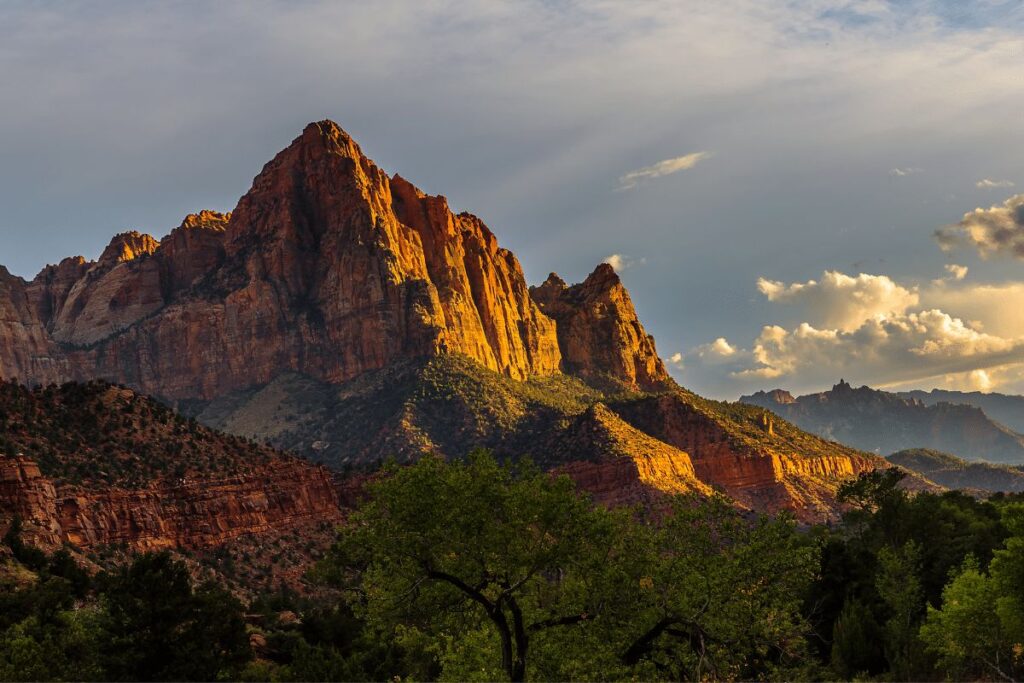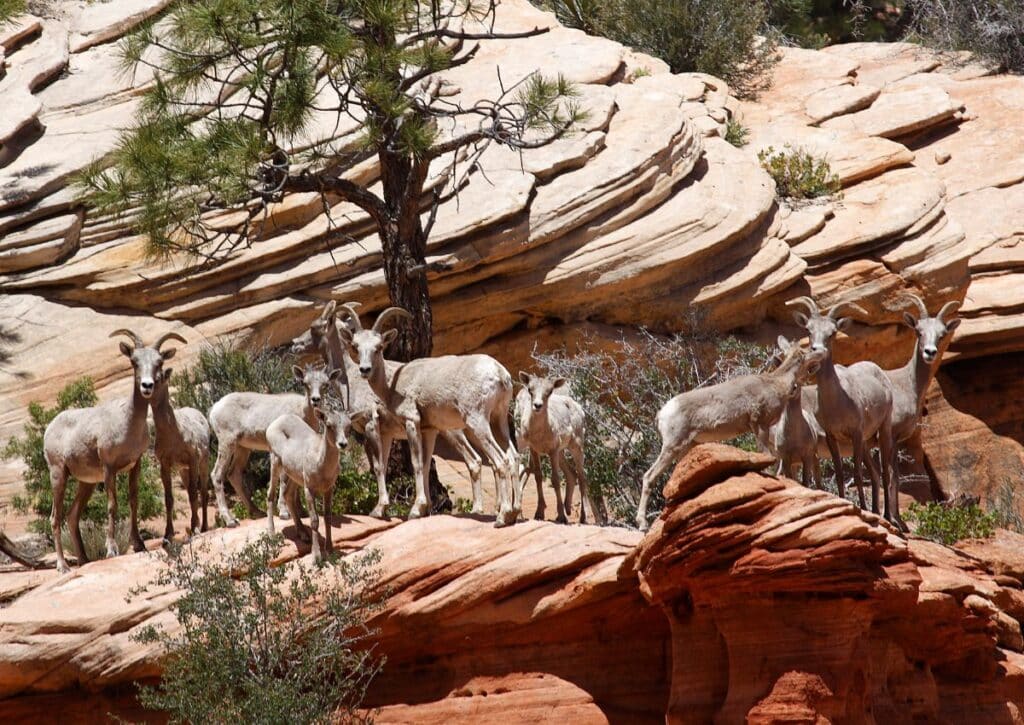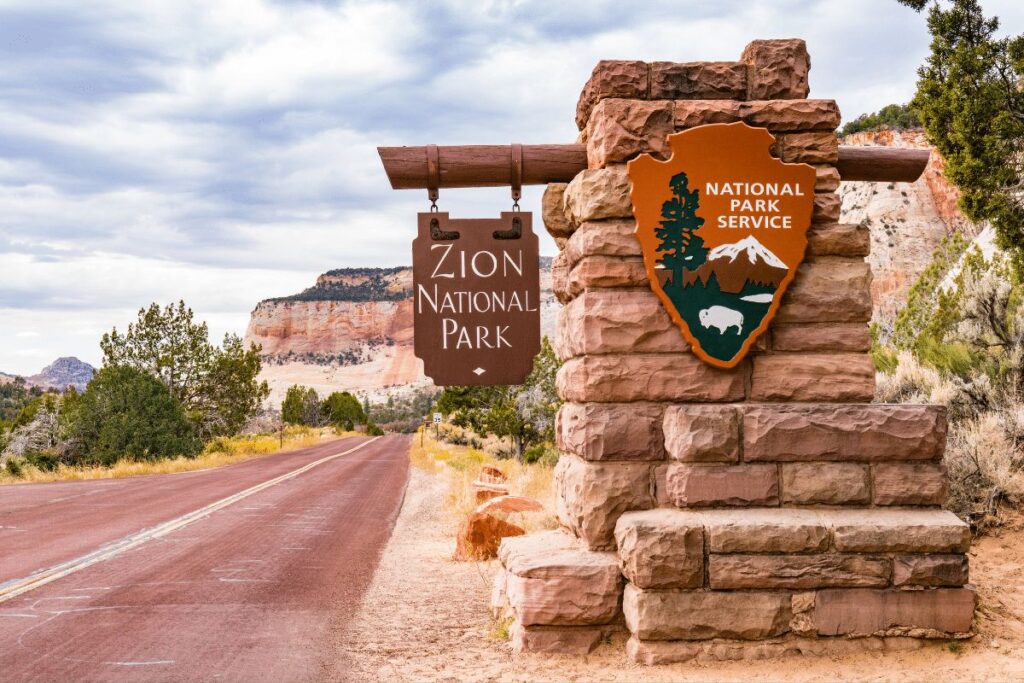Discover 11 epic rock formations in Zion National Park for hikers. Experience stone giants like Angels Landing and more.
Get ready to be awestruck by Zion National Park’s spectacular rock formations! This isn’t just a walk in the park – it’s a journey through a stone-crafted masterpiece.
We’re talking about the likes of Angels Landing and the Great White Throne—monoliths that don’t just scrape the sky, they stun onlookers into silence.
Our adventure will carve a path through the beehive-shaped spires, navigate the Court of the Patriarchs, and stand in the shadow of the towering Mountain of the Sun.
With each step, prepare to uncover the stories etched in stone by millennia of wind and water. Rock enthusiasts and photo-seekers alike, these 11 formations are Zion’s silent giants waiting for you. This isn’t just sightseeing; it’s rock reverence.
Beehives
The Beehives are a group of seven small domed mountains located in the southwestern corner of Zion National Park. They are named for their resemblance to bee honeycombs. The Beehives offer a challenging but rewarding hike, with incredible views of the surrounding scenery.
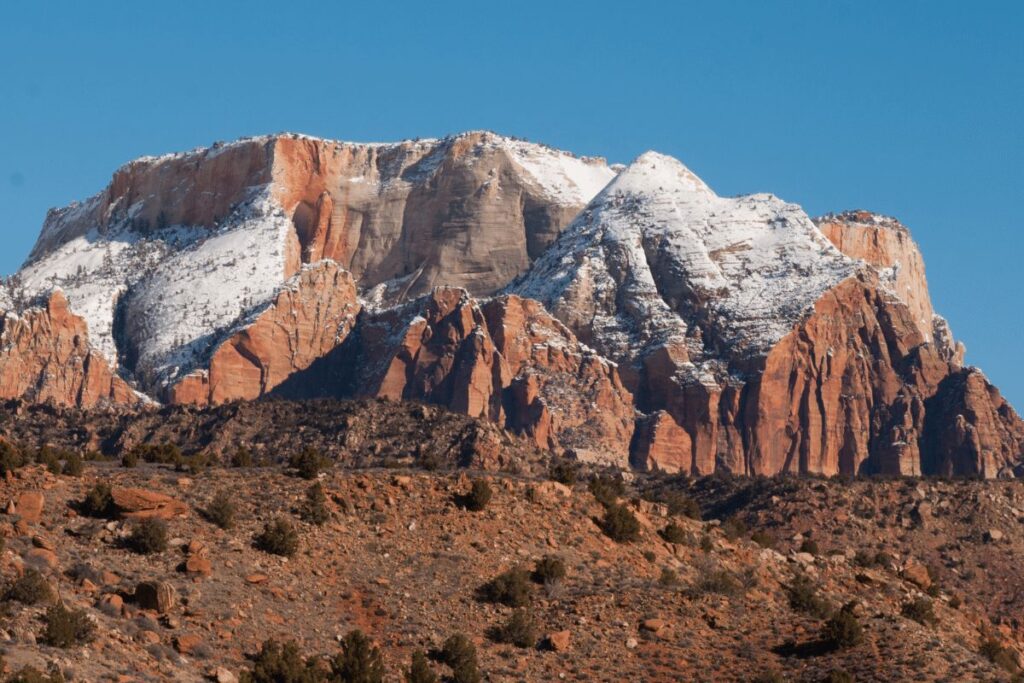
To get to the Beehives, start at the trailhead near the park entrance. From there, follow the marked trail for about two miles until you reach the base of the domes. From there, it’s a steep climb to the top of any of the Beehives, but the views are worth it!
Once you’ve reached the top, take some time to enjoy the stunning views and catch your breath. Then, head back down the way you came and bask in the sense of accomplishment that comes with completing this unique hike.
Angels Landing
Angels Landing is a very unique place in Zion National Park. The trailhead is located near the Grotto Picnic Area. The trail is a 5-mile round trip hike with an elevation gain of 1,488 feet. The last half-mile of the trail is very steep with switchbacks and drop-offs.
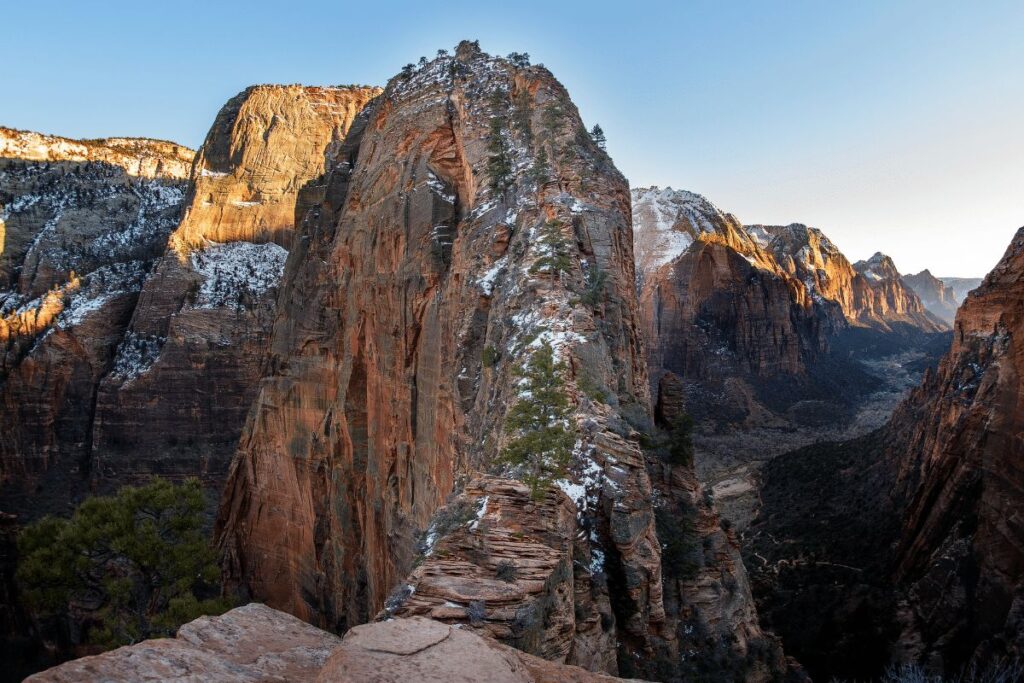
This section of the trail is not recommended for hikers who are afraid of heights. There are several chains along the trail to help hikers with their ascent. Once you reach the summit, you will be rewarded with stunning views of Zion Canyon!
Despite its difficult terrain, the summit provides one of the most rewarding views in the park. It also serves as an excellent gateway to many other trails in Zion Canyon.
Whether you’re looking for a challenge or just want to take in the amazing sights, Angels Landing is definitely worth a visit!
The Watchman
The Watchman is one of the most iconic rock formations in Zion National Park. This natural wonder stands at 6,564 feet and is a popular spot for both hikers and photographers. The trail to the summit of The Watchman is a moderate 3.8-mile hike that provides stunning views of the surrounding park and valley.
Court of the Patriarchs
The Court of the Patriarchs is a popular geological formation located in Zion National Park in the southwestern United States. This stunning landmark is named after three towering sandstone cliffs, which are said to resemble the bearded faces of Abraham, Isaac, and Jacob, the patriarchs of the Hebrew Bible.
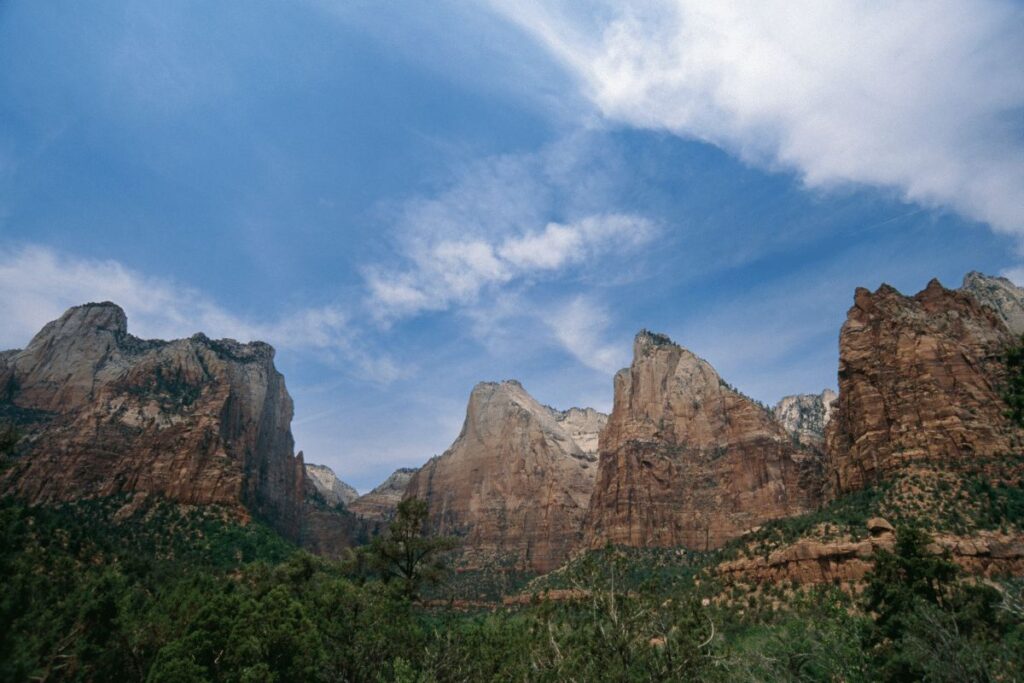
These massive sandstone cliffs rise to a height of over 6,500 feet and are a striking feature in the park’s stunning landscape. They are part of the Navajo Sandstone formation, which is made up of layers of rock that were deposited over 150 million years ago in a vast desert environment.
Over time, the wind and rain eroded the softer layers of rock, leaving behind the harder sandstone cliffs that make up the Court of the Patriarchs.
Visitors to Zion National Park can access the Court of the Patriarchs via a short walking trail that leads to a viewpoint. The trail is less than a mile long and is considered an easy hike, making it suitable for all skill levels.
The viewpoint provides breathtaking panoramic views of the sandstone cliffs and the surrounding valley, and it’s an excellent spot to take photos and soak in the beauty of Zion National Park.
Aside from its geological significance, the Court of the Patriarchs also has cultural and historical importance. Native American tribes, including the Paiute and Ute people, have lived in the area for thousands of years and consider the site to be sacred.
In the late 1800s, European settlers began exploring the area, and the Court of the Patriarchs quickly became a popular destination for tourists.
Today, the Court of the Patriarchs remains one of the most popular and photographed landmarks in Zion National Park. It’s a must-see for anyone visiting the area, and its unique geological features and cultural significance make it a fascinating destination for all.
Cable Mountain
Cable Mountain is a prominent mountain peak located in Zion National Park in the state of Utah, United States. This impressive summit is part of the park’s natural skyline and is a popular destination for hikers and outdoor enthusiasts.
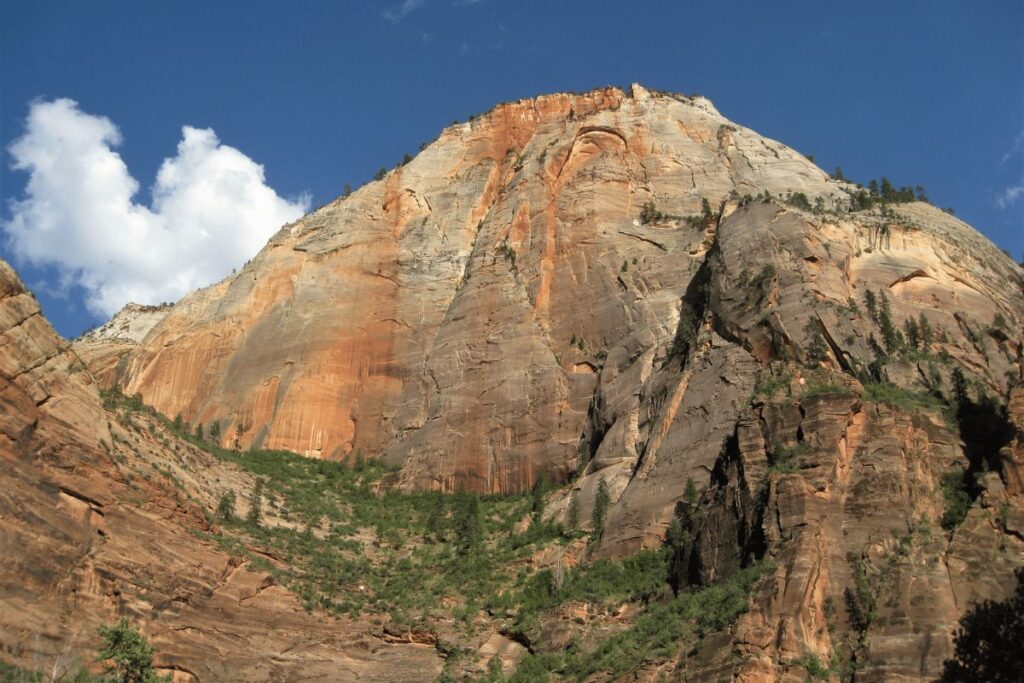
The origin of Cable Mountain’s name comes from the large cable system that was constructed in the late 1800s to transport timber from the mountain down to the nearby town of Springdale. The cable was used to lower logs from the mountain to the town using gravity, making it easier and safer for loggers to transport their timber. The remains of the cable system can still be seen today, and the mountain continues to bear the name “Cable Mountain” in honor of this historic engineering feat.
Cable Mountain rises to a height of 7,276 feet and is part of the same geological formation as other landmarks in Zion National Park, such as the Court of the Patriarchs. The mountain’s location provides stunning views of the surrounding area, including the park’s famous red rock formations, forests, and canyons.
The hike to Cable Mountain is a strenuous and challenging 15-mile round trip trek that is recommended for experienced hikers. The trailhead is located near the Weeping Rock trailhead, and the path meanders through steep switchbacks, forests, and exposed rock formations.
Along the way, hikers are rewarded with breathtaking views of the park and the chance to spot local wildlife such as mule deer, wild turkeys, and the elusive mountain lion.
Once at the summit, hikers are treated to sweeping views of the surrounding area, including Zion Canyon and the Virgin River. The summit also features the remains of a historic cable car station, which once transported timber down the mountain. Today, the site serves as a popular destination for visitors seeking a glimpse into the area’s history and natural beauty.
Kolob Arch
Kolob Arch is a massive natural sandstone arch located in the Kolob Canyons section of Zion National Park in southern Utah, United States. With a span of 287.4 feet, it is considered one of the largest free-standing arches in the world. The arch is situated in a remote section of the park, accessible only by a strenuous hiking trail that requires a backcountry permit.
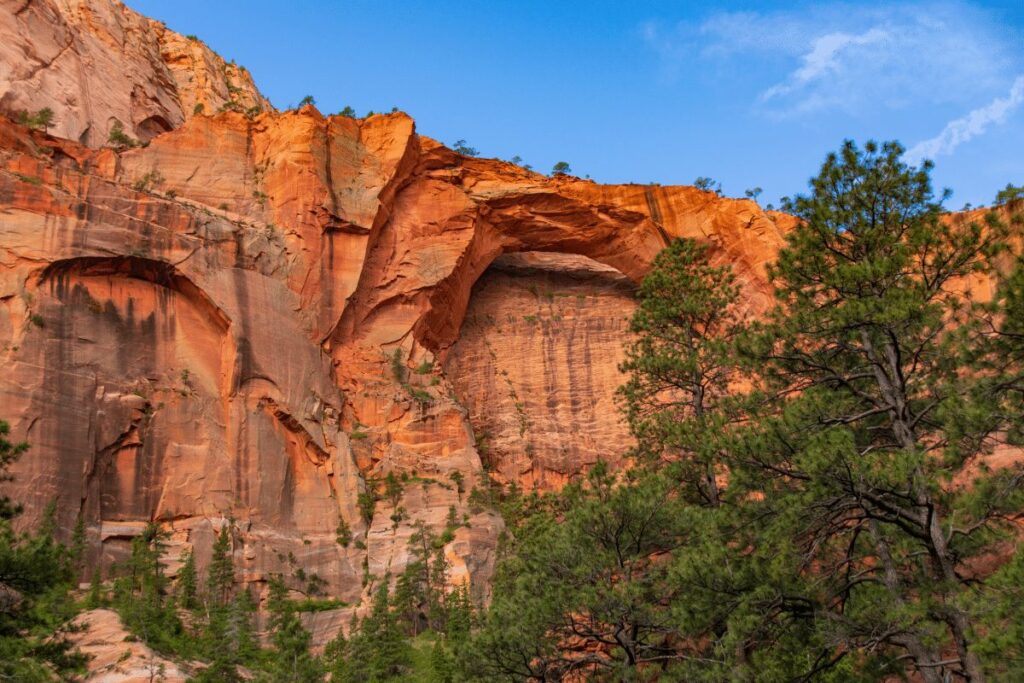
Kolob Arch was first documented by a National Park Service ranger in the 1920s, and it quickly became a popular destination for hikers and rock climbers. The arch is formed from the same Navajo sandstone that characterizes the park’s geology and is thought to be over 150 million years old.
To reach Kolob Arch, visitors must hike along a challenging 14-mile round-trip trail that begins at the Lee Pass Trailhead in the Kolob Canyons section of the park. The trail follows the rugged terrain of the Kolob Canyons, taking hikers through steep switchbacks and across several small streams. Along the way, hikers are treated to stunning views of the surrounding landscape, including towering sandstone cliffs and deep canyons.
Upon reaching the arch, hikers are rewarded with breathtaking views of one of the world’s largest natural arches. The massive span of Kolob Arch towers over the surrounding landscape, and its unique shape and beauty leave a lasting impression on those who visit.
The hike to Kolob Arch is considered strenuous and requires a backcountry permit, as the trail passes through remote and rugged terrain. Visitors are advised to be prepared with appropriate hiking gear, including sturdy hiking shoes, plenty of water, and food. It is also recommended to start the hike early in the day to avoid the midday heat and to allow plenty of time for the journey.
Mountain of the Sun
Mountain of the Sun rises to a height of 6,722 feet (2,049 m) in Zion National Park, in southwest Utah. It towers more than 2,500 feet (760 m) above Zion Lodge and the canyon floor. Situated east of Court of the Patriarchs and south of Zion Lodge, it is neighboured by The Sentinel, Mount Spry, The East Temple, and Mount Moroni.
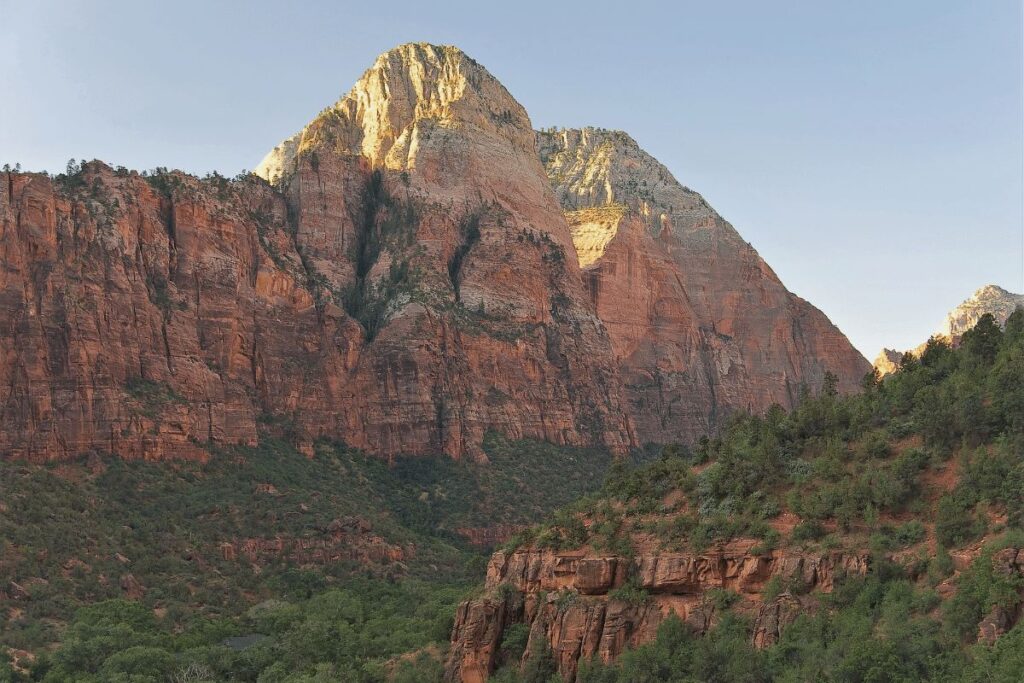
Its name was officially adopted in 1934 by the U.S. Board on Geographic Names. The mountain also overlooks the North Fork of the Virgin River which collects precipitation runoff from its peak.
Spring and autumn are the best times of year to visit Mountain of the Sun. This desert land experiences less than 250 millimetres (10 inches) of rain each year, while snowfall is usually light during winter.
The Mountain of the Sun trail is a moderate hike that winds its way up the side of the mountain. The views from the trail are absolutely amazing, and you’ll get to see some incredible rock formations up close. The hike takes about 3-4 hours to complete, and it’s definitely worth it for the amazing views.
Checkerboard Mesa
Checkerboard Mesa is a massive uplifted plateau made of Navajo Sandstone, which is a type of rock that is found throughout the park. The formation gets its name from the unique pattern of crosshatching lines that are visible on its surface, which create a distinctive checkerboard-like appearance. It rises to a 6,520+ ft (1,990+ m) elevation.

The Checkerboard Mesa formation is believed to be over 180 million years old and is one of the most recognizable features in Zion National Park. It is visible from many locations throughout the park and is a popular destination for visitors due to its unique appearance and accessibility.
The best way to experience Checkerboard Mesa is by hiking to the top. The hike is relatively easy and only takes about an hour round trip. From the top, you’ll be rewarded with stunning views of Zion Canyon.
Observation Point
This scenic overlook offers panoramic views of the park’s unique geological formations, including Zion Canyon and the surrounding plateaus.
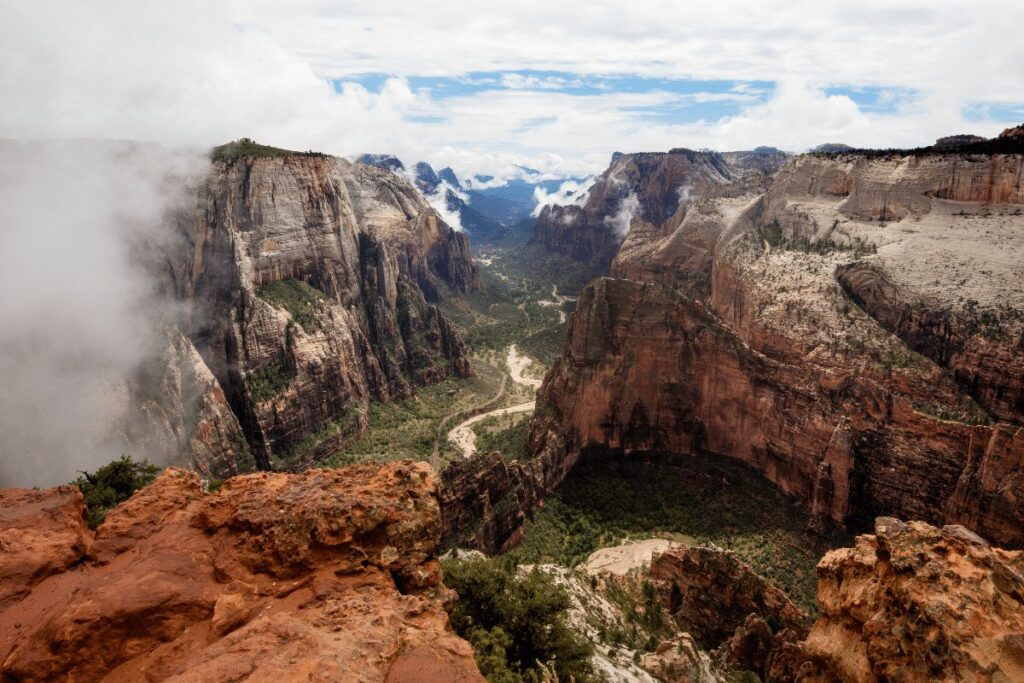
The trail to Observation Point is a strenuous 8-mile round trip hike that begins at the Weeping Rock Trailhead in the park’s main canyon. The trail features steep switchbacks and gains over 2,000 feet in elevation, making it a challenging trek for hikers. However, the stunning views at the top are well worth the effort.
The hike takes hikers through a variety of landscapes, including lush forests, towering cliffs, and exposed rocky terrain. Along the way, hikers will encounter a diverse array of flora and fauna, including desert bighorn sheep, mule deer, and a variety of birds.
As hikers approach the summit, they are treated to stunning views of the park’s iconic rock formations, including the Great White Throne, Angels Landing, and Cathedral Mountain. The Observation Point viewpoint offers an unobstructed 360-degree view of the park and is a popular spot for photographers and nature enthusiasts.
In addition to the stunning views, the hike to Observation Point also provides visitors with a chance to explore the park’s natural beauty and history. The trail passes through several historic sites, including the East Rim Trail, which was once used by Native American tribes as a trade route, and the Weeping Rock, a natural spring that cascades down the cliffs.
Lady Mountain
Lady Mountain located in Zion National Park, renowned for its spectacular cliffs and big wall climbing, lies opposite the Zion Lodge. This sandstone monolith was originally named Mount Zion because of a part of the climb which resembles a woman’s face above Emerald Pools.
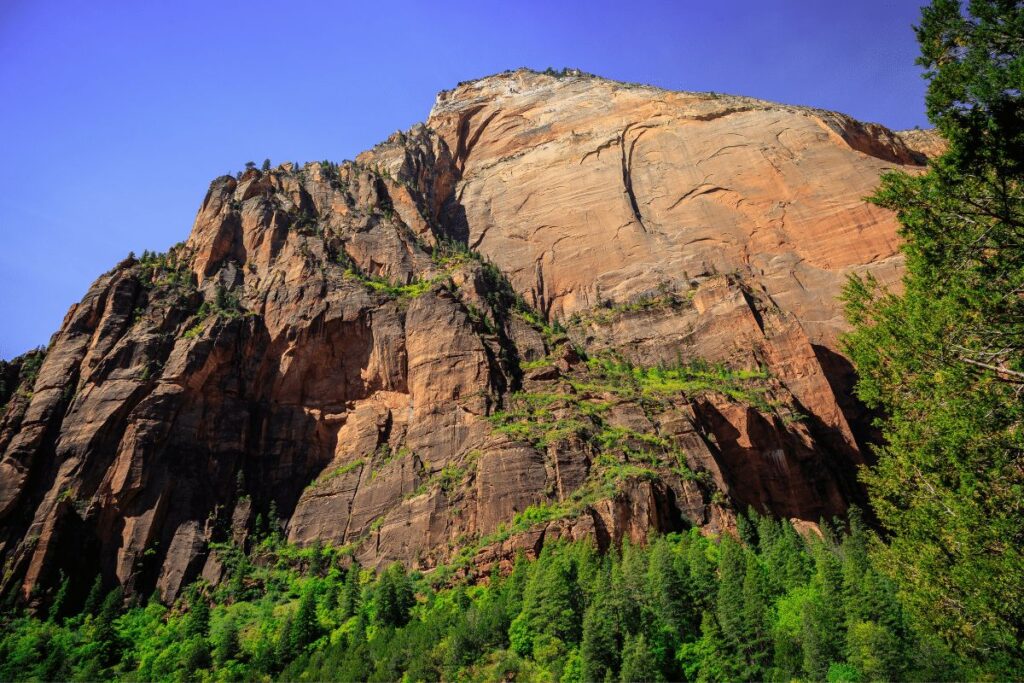
It was also the first ever trail that lead to the peak of any monolith in the park, an impressive feat considering it is composed of Navajo Sandstone from the Mesozoic period.
This is an out-and-back trail of 4.0 km near Springdale, Utah. This trail is a popular hiking and rock climbing trail, but it is also a place to experience some solitude during quieter times of the day.
Generally considered a challenging route, it takes about three hours and 34 minutes to complete. You can visit the trail at any time of the year, and it is beautiful to see.
Towers of the Virgin
Few geological features are as distinctive and awe-inspiring as the towering sandstone spires of Zion National Park.
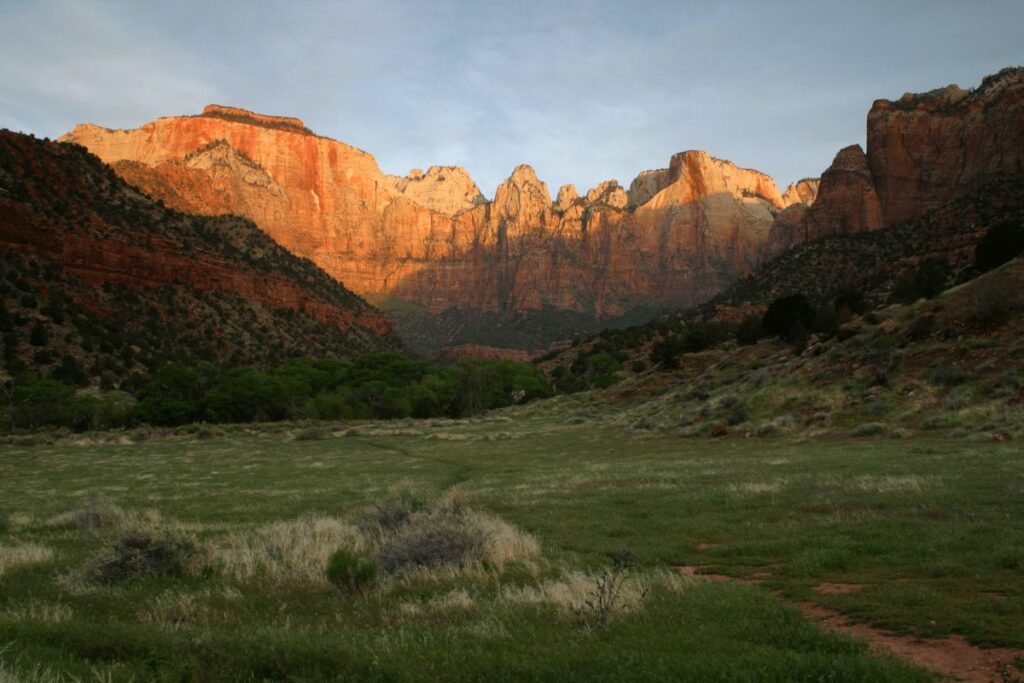
The Virgin River has cut through the sandstone over millions of years, carving out a dramatic canyon landscape. The red, pink, and white rocks make for a beautiful contrast against the deep blue skies.
The peaks of the Towers of the Virgin (from south to northeast) include: The Sundial, The Witch Head, Broken Tooth, Rotten Tooth, Altar of Sacrifice, Meridian Tower, Bee Hive, and The Sentinel.
The Towers of the Virgin have also been known as Rock Rovers’ Land, Temples of the Virgin, and Tu’-Mu-Ur-Ru-Gwait’Si-Gaip Tu-Weap’ and were included in the original boundaries of what was known as Zion National Monument.
The Great White Throne
When most people think of Zion National Park, they think of the majestic red rocks that dominate the park. But did you know that Zion also has some amazing white rock formations?
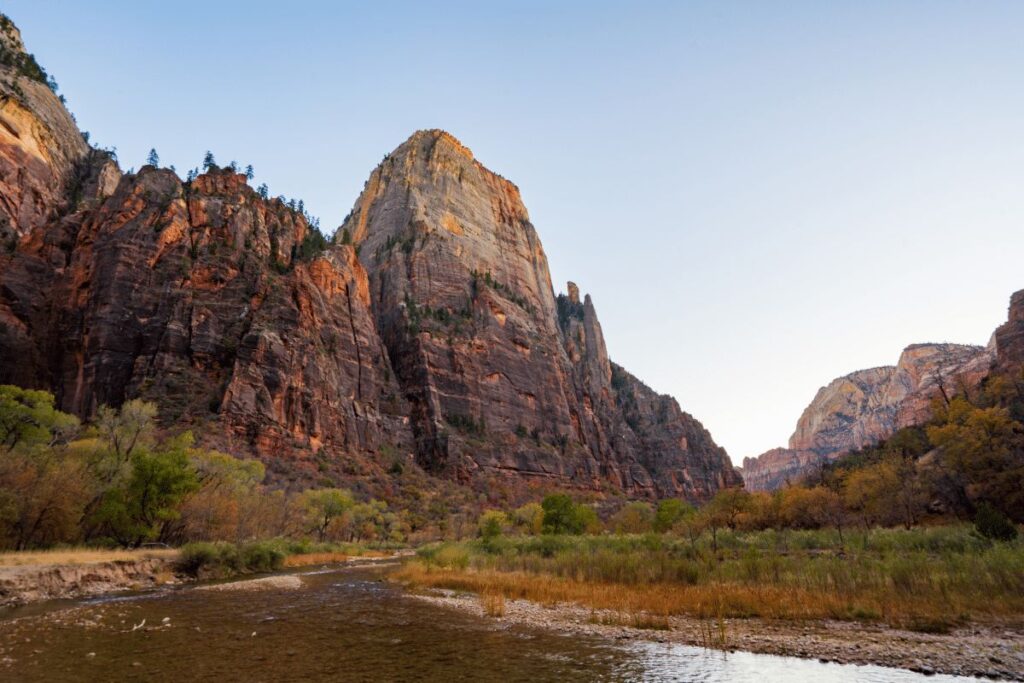
The Great White Throne is a monolith primarily made of white Navajo Sandstone. Near Angels Landing, the north-west “main” face rises 2,350 feet (720 meters) and 1,500 feet (460 meters) from the ground. The Great White Throne is often used as a symbol of Zion National Park. It can be seen from most places along the scenic drive in Zion Canyon.
Conclusion
If you’re looking for a great outdoor adventure, then visiting Zion National Park is a must! With its amazing rock formations and incredible hiking trails, it’s sure to be an unforgettable experience.
Not only will you have the opportunity to explore some of the most spectacular natural wonders in the world, but you can also challenge yourself on some of these difficult hikes and enjoy views that no other park has to offer. Make sure to plan your trip ahead so you can make the most out of your visit to Zion National Park!

